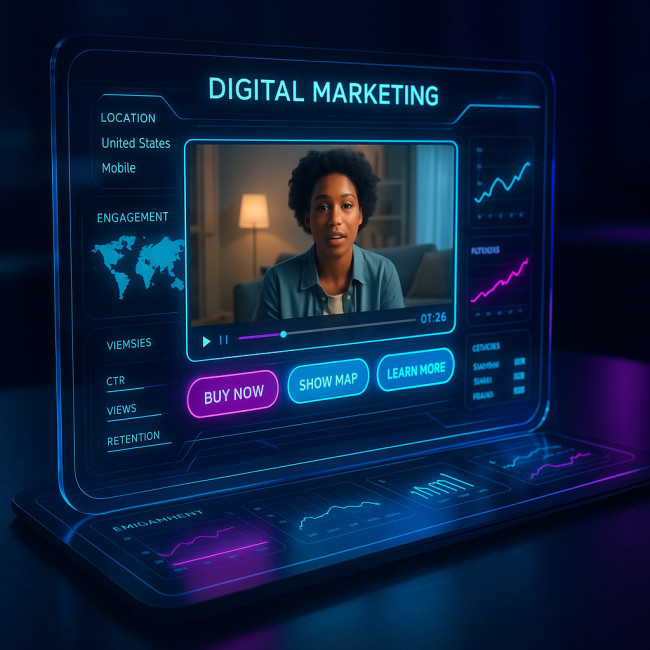Interactive video files: add hotspots and chapters to boost engagement metrics
Viewers today expect to click, swipe and explore. By turning standard footage into interactive video files—complete with clickable hotspots and searchable chapters—you can double watch-time, lift conversion rates and feed your analytics with richer insights. This guide walks you through benefits, set-up workflows and measurement tactics that prove ROI to any stakeholder.
Why interactive video files are overtaking passive playback

On social feeds and corporate learning hubs alike, attention spans shrink while content volumes climb. Static clips rarely hold visitors past the 40 % mark, yet interactive video files that invite action keep viewers focused and curious. Interactive layers turn spectators into participants—an effect that translates directly into more minutes watched, stronger message recall and higher click-through to your next step.
“Interactivity is not a gimmick; it's the shortest path between a question in the viewer's mind and the answer you want them to discover.”
- Hotspots spark micro-engagement every few seconds, preventing drop-offs.
- Chapters offer a built-in table of contents, so viewers jump straight to the portion that solves their problem—no tedious scrubbing.
- Both features feed granular heat-map data into your dashboard, revealing which scenes drive action and which need refinement.
Hotspots: the click-worthy layer inside any interactive video file
What is a hotspot?
A hotspot is a transparent clickable zone overlaid on your video timeline. When a viewer taps or hovers, the hotspot can:
- Reveal extra text, images or audio without pausing the main playback.
- Jump to a different timecode or to a separate branch of the story.
- Open an external resource, such as a project brief, sign-up form or directory of professional videographers.
Design rules that keep viewers clicking
- Limit per scene: two hotspots per 10 seconds prevents overwhelm.
- Contrast on any device: outline the clickable area in brand colors and include a hover state for desktop viewers.
- Accessible cues: add voice-over prompts and ARIA labels so screen-reader users can navigate each interactive video file easily.
- Contextual value: every hotspot must answer a “What's in it for me?” question within one second.
Need help refining hotspot copy? The article testimonial interviews that unlock repeat video commissions shows how to transform viewer curiosity into trust-building micro-stories.
Video chapters: structure that multiplies watch-time
Why your timeline needs chapters
Modern audiences skim just like they do with blog posts. Chapters in interactive video files serve the same role as sub-headings: they shorten the path to value. Viewers can:
- Jump ahead without fear of missing context.
- Return to a critical segment for quick replays.
- Share a timestamped link that promotes your content organically.
SEO bonus
Platforms such as YouTube index chapter titles. Descriptive labels—“Step-by-step colour grade” instead of “Part 3”—make your clip surface for long-tail queries and boost discoverability alongside tactics in local SEO for videographers.
Naming formula that works
| Goal | Chapter Title Formula | Example |
|---|---|---|
| Tutorial | Verb + Outcome | “Export 4K master with tiny file size” |
| Product demo | Problem + Fix | “Shaky footage? Activate gyro stabiliser” |
| Case study | Metric + Timeframe | “11 % cost saved in three weeks” |
Adding hotspots and chapters: a six-step workflow
- Storyboard interactivity during pre-production. Sketch where questions appear and craft the hotspot response. Our pre-production questionnaire prompts help extract those questions early.
- Edit baseline footage and lock picture. Hotspots depend on timecodes, so finalise cuts first.
- Create chapter markers in your NLE (Premiere, Final Cut, DaVinci). Export an XML or SRT with titles.
- Upload to an interactive platform (e.g., Wistia, Vidyard, Vimeo Interactive). Import chapter file.
- Draw hotspots using platform tools. Connect each to a URL, skip or overlay.
- QA on multiple devices. Test that every interactive element triggers under touch, mouse and keyboard navigation.
Measure the engagement lift
Don't stop at view counts. Interactive video files unlock deeper metrics:
- Heat-maps: reveal the exact second most viewers pause or click.
- Completion rate by chapter: shows which topics resonate.
- Interaction click-through rate (iCTR): hotspot clicks ÷ total impressions.
- Conversion rate: combined effect of chapters guiding and hotspots persuading.
Export these numbers into your BI tool or cross-reference with tactics in footage repurposing roadmaps to prove how each layer fuels downstream assets.
Case study: 30-day metric lift
A B2B SaaS brand replaced its static explainer with an interactive video file featuring three hotspots (“Book demo”, “See pricing”, “Tech specs”) and five chapters. Results after one month:
- Average watch-time leapt from 1 min 42 s to 3 min 17 s (+91 %).
- Demo bookings jumped from 1.3 % to 3.8 % of viewers.
- Heat-map revealed 68 % re-watched the “integration setup” chapter—data later used to build a dedicated onboarding mini-series.
Platform comparison cheat-sheet
| Feature | Wistia | Vidyard | Vimeo Interactive |
|---|---|---|---|
| Hotspot editor | Drag-and-drop, branching | Overlay CTAs, forms | Clickable shapes |
| Chapter import | SRT/XML | Manual or CSV | Timeline markers |
| Analytics depth | Per-viewer heat-map | HubSpot sync | Engagement graph |
| Free tier | Yes (3 videos) | Yes (limited) | No |
Interactive video files and accessibility
Remember that interactivity must serve every user:
- Provide keyboard focus outlines and ARIA labels on each hotspot.
- Offer text summaries for chapter titles and hotspot content.
- Contrast-check overlay colours to ensure readability for colour-blind viewers.
Future-proofing: pair interactivity with personalisation

Dynamic video platforms can alter hotspot offers based on viewer segments (location, CRM tag, device). Combine this with interactive video files to show local currency or language-specific case studies, similar to geo-targeting tips in regional targeting strategies.
FAQ
- Do hotspots slow down video load times?
- No. Hotspots are lightweight HTML overlays that load after the core video, keeping initial buffering fast.
- Can I add hotspots to existing videos hosted on YouTube?
- YouTube offers limited end-screen interactions but not true hotspots. Download the master file and re-host on an interactive platform for full control.
- How many chapters are optimal?
- Between five and ten. Too few defeats the purpose; too many can look cluttered on mobile.
- Which metrics impress stakeholders most?
- Watch-time per visitor and conversion rate from hotspot clicks to goal completion are easiest to tie back to revenue.
- Is coding knowledge required?
- No. Most leading platforms provide visual editors. Basic understanding of timecodes helps but is not mandatory.
Mini-quiz: Test your interactivity IQ
Next step: turn knowledge into results
Interactive video files excel only when published. Pick one existing asset, add two hotspots and a clear set of chapters, then track watch-time for 14 days. The uplift will speak louder than any pitch deck—and push your team to scale interactivity across the entire library.
Ready to create your first interactive masterpiece? Dive into our action-oriented resources and keep experimenting until every viewer becomes an active participant.











